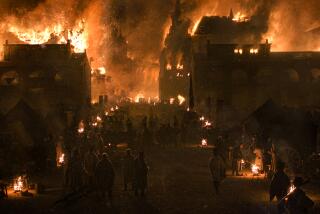Sea Yields Secrets of Nelson’s Great Battle
- Share via
At 10 o’clock on the evening of Aug. 1, 1798, Napoleonic France’s hopes of dominating the Mediterranean and India literally exploded in Aboukir Harbor at the mouth of the Nile River in Egypt. The 2,000-ton L’Orient, the flagship of Napoleon’s fleet and one of the grandest frigates of its time, disintegrated in a massive explosion that blew three-ton cannons more than half a mile away and was heard by troops more than 20 miles inland.
During the course of the evening and night, an outgunned, outmanned British force led by Adm. Horatio Nelson annihilated the French fleet, capturing or destroying 11 of the 15 enemy frigates in what has been called one of the most decisive naval battles in history.
Now, a team of French archeologists has explored and mapped the underwater burial ground of the French navy, retrieving unique artifacts from the shattered vessels and providing new insights into how Nelson achieved his victory.
“This is where the fate of Europe was decided,” the leader of the expedition, Franck Goddio, said in a recent interview. “It is a magnificent find.”
The wreck of L’Orient was discovered in 1983, but it was only this summer that Goddio’s team was able to accurately map the sea floor in the area and retrieve some of the many artifacts lying scattered under eight feet of mud.
Among other discoveries, they have concluded that L’Orient was the victim of not one, but two near-simultaneous explosions so massive that they caused other ships in the area to stop fighting for more than half an hour. Booty from the sacking of Malta, thought to have been removed from L’Orient when she docked at Alexandria, was still cached in her hold. And other frigates in the battle, recognizing the imminent doom of the flagship, fled from her in panic lest they be consumed in her destruction.
Among the artifacts found on the sea bottom 35 feet below the surface are skeletons of the crew, mangled cannons, parts of the hull, L’Orient’s 35-foot, one-ton rudder, seven anchors, bottles, sabers, buttons bearing regimental insignia, a printing press and large amounts of type.
By 1798, England had been depleted by the American War for Independence and continuing battles with France. All her allies had been defeated and Spain had changed sides, defecting to Napoleon’s cause. Bolstered by his massive fleet, Napoleon had taken some 40,000 troops ashore in Egypt with the intention of conquering the country and attacking the British in India.
His fleet, consisting of the 120-gun L’Orient, three 80-gun frigates and nine 74-gunners, was anchored in a curving picket line across Aboukir Bay, 23 miles east of Alexandria. It was protected by its own guns and batteries on shore.
Nelson, who had only 11 74-gun frigates and one 50-gun vessel, had been searching the Mediterranean for the French fleet when he finally found it late on August 1 and immediately attacked.
The French vessels were anchored far enough from shore that the British force was able to divide into two groups and sail along both sides of the French vessels, raking them with cannon fire. While the French had to divide their manpower to fire broadsides against both forces, the English could concentrate their manpower on one side of each frigate, neutralizing the French advantage.
The positioning of the French ships so far from shore has been attributed to an error on the part of the French commander, Vice Adm. Francois Brueys. But Goddio’s mapping of the floor shows that they couldn’t get any closer. The depth at the site was only nine meters (27 feet), barely enough to accommodate the 8.2-meter (25-foot) draft of the French ships.
The smaller British ships were thus able to maneuver freely between the French fleet and the shore.
Goddio’s team found seven anchors arrayed around the site of L’Orient, indicating what must have been a pocket of heavy fighting. But when the L’Orient caught fire, the commanders of the ships cut their anchors and fled to escape the force of the explosion.
And what an explosion it was, Goddio said. The fire initially touched off L’Orient’s own black powder stores in the stern, and that explosion triggered a secondary blast of powder for the land forces stored in the bow. Even today, Goddio said, remnants of the powder can be detected underwater and divers come back to the surface coated with residue. The ship’s middle section was not destroyed, however, supporting the conclusion that L’Orient was demolished by two separate blasts.
Goddio’s team also found the remains of the Serieuse and the Artemise, the two smallest frigates in Napoleon’s fleet. When the Serieuse’s captain saw that the British were attempting to get between the shore and the French, he immediately attempted to block them, but was sunk. The Artemise also suffered an early demise and was burned.
Goddio’s excavations are sponsored by the Discovery Channel, which will premiere a documentary about the new finds Aug. 29.
Further information about the battle is available at:
www.rjt.co.uk/Nelson/html/the_nile.htm
www.hillsdale.edu/dept/History/Documents/War/Navy3/1799-NileNelson.htm and
www.thehistorynet.com/MilitaryHistory/articles/1998/08982_text.htm
More to Read
Sign up for Essential California
The most important California stories and recommendations in your inbox every morning.
You may occasionally receive promotional content from the Los Angeles Times.












